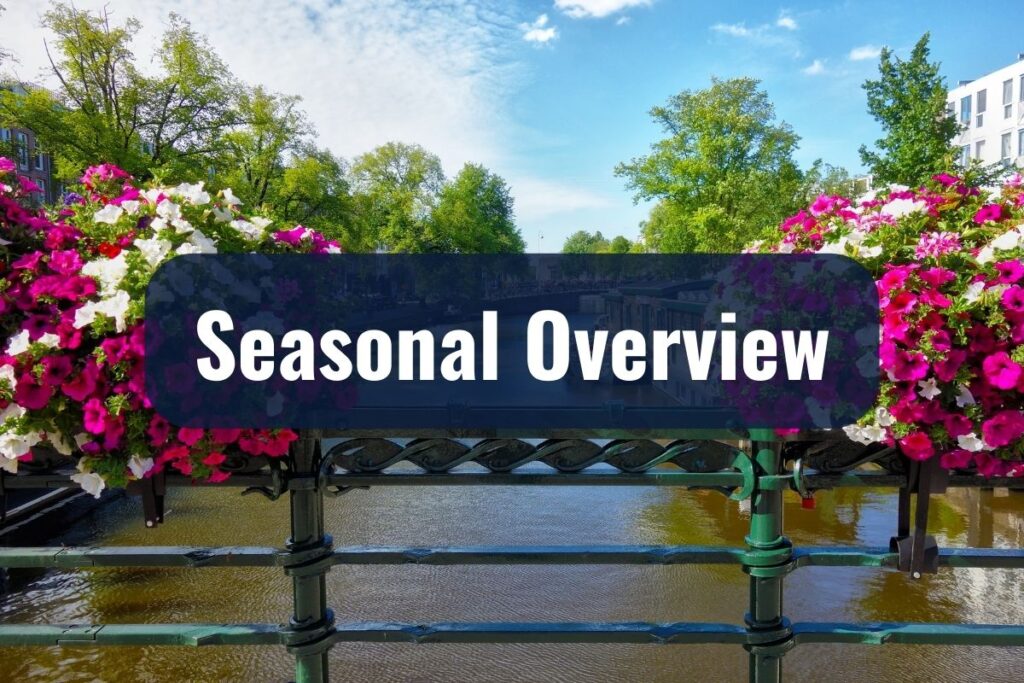The climate in the Netherlands, while moderate, carries its own set of quirks that can sometimes be puzzling to newcomers.Whether it’s the unpredictability of rain showers or the brisk North Sea breezes, understanding the weather in the Netherlands is essential for making the most of your stay.
In this article, we’ll delve deep into the heart of the Dutch climate, offering insights and practical advice to help you navigate your days comfortably and confidently.
Key Takeaways:
- The Netherlands boasts a temperate maritime climate shaped by its unique geography.
- Each season in the Netherlands offers distinctive weather patterns and charm.
- The Dutch weather, though variable, can be navigated with proper attire and preparation.
- The climate influences many aspects of Dutch life, from everyday activities to grand festivities.
- Engaging with the community and local resources enhances acclimatization to Dutch weather.
Geographical Influences on the Climate in the Netherlands
The climate of the Netherlands, while influenced by various factors, is predominantly shaped by its geographical location and topography. Let’s unpack these elements to get a clearer picture of what influences the weather patterns you’ll experience.
The North Sea’s Moderating Effect
Located to the northwest of the country, the North Sea plays a pivotal role in determining the weather patterns in the Netherlands. Due to the proximity of this vast water body, the country experiences what is known as a maritime or oceanic climate. This means that the temperatures are relatively moderate throughout the year.
In the winter, the sea’s warmth ensures that extreme cold is rare, while in the summer, its cooling effect prevents excessively high temperatures. However, the North Sea also brings with it moisture-laden winds, leading to the country’s well-known drizzly and rainy days.
Low-lying Topography and its Implications
The Netherlands is often fondly referred to as “Low Country,” and for a good reason. A significant portion of its land is at or below sea level, with its intricate system of dikes and canals helping to keep the water at bay. This low-lying landscape, devoid of significant mountains or hills, allows the westerly winds from the sea to sweep across the country uninhibited.
As a result, the weather can change rapidly, and cloud formations are often driven from the coast to the inland areas without much to block or alter their path.
Seasonal Overview

As you settle into life in the Netherlands, you’ll quickly discover that each season paints the country with a distinctive brush, bringing its own set of charms, challenges, and weather peculiarities. Let’s navigate through the Dutch calendar, exploring what each season has in store for its inhabitants.
| Season | Duration | Characteristics |
| Winter | December-February | Chilly with occasional snow, shorter days |
| Spring | March-May | Mild temperatures, blooming tulips, alternating showers and sunshine |
| Summer | June-August | Warm with short rain showers, long daylight hours |
| Autumn | September-November | Cooling temperatures, picturesque landscapes, increased rainfall |
Winter
The Dutch winter, spanning from December to February, can be described as chilly but not extremely cold. While snowfall isn’t a daily occurrence, it’s not uncommon to see the country adorned in a thin blanket of white a few times during the season.
Temperatures typically hover around freezing point, but severe frosts are rare. The days are shorter, with twilight settling in early, which lends a cozy ambiance, especially in towns illuminated with festive lights.
Spring
Ah, springtime! From March to May, the Netherlands awakens from its winter slumber. Gradually, temperatures rise, and the days lengthen. This is the time when the famous Dutch tulips burst into bloom, particularly in April, transforming vast landscapes into a riot of colors.
Rain showers can still be frequent, but they often alternate with clear skies and sunshine, giving the world a freshly washed appearance.
Summer
Running from June to August, the Dutch summer is pleasantly warm without becoming stifling. Temperatures usually settle between 20°C to 25°C, though occasional heatwaves can push the mercury further up. Rainfall is a familiar companion even during these months, often presenting itself in the form of short, intense showers.
Thankfully, long daylight hours mean you can still enjoy extended beach and outdoor activities, be it picnics in the park or leisurely evening canal cruises.
Autumn
September signals the onset of autumn, a season characterized by cooling temperatures and a transformative landscape. The once-green leaves adopt hues of gold, amber, and crimson.
While this is undeniably one of the most picturesque times in the Netherlands, be prepared for increased rainfall and gusty winds. It’s a time of transition, as the country prepares to embrace the oncoming winter.
Related: The Best Water Parks in the Netherlands: Guide & Tips (2024)
Typical Weather Conditions and What to Expect
Navigating through a new country often involves adapting to its typical weather patterns. In the Netherlands, there are certain weather conditions that, once familiar with, can aid in planning your days more effectively. Here’s a snapshot of the most common weather conditions and what you might expect from them.
Rain
If there’s one word that often pops up in discussions about Dutch weather, it’s ‘rain’. While it might seem like it rains incessantly, the truth is a tad more nuanced. The Netherlands does experience a fair number of rainy days, but they often consist of intermittent drizzles or short showers rather than prolonged downpours.
It’s always a good idea to carry a compact umbrella or don a waterproof jacket when heading out, even if the morning starts off clear.
Wind
The flat landscapes of the Netherlands, combined with its coastal location, make it a breezy country. Coastal regions, in particular, experience strong winds, which can sometimes make cycling (a favorite Dutch mode of transportation) a bit challenging. However, the winds also bring in fresh air, ensuring the country rarely feels stifling, even in summer.
If you’re planning on biking or spending time near the coast, be prepared for gusts and perhaps invest in some wind-resistant clothing.
Temperature Fluctuations
While the maritime climate ensures no extreme temperatures, the Netherlands has some seasonal variability. For instance, a summer day might begin cool and overcast, only to warm up and clear by the afternoon. Conversely, a sunny winter morning might give way to a chilly, cloud-covered afternoon. Keeping an eye on daily forecasts and dressing in layers can be your best strategy to combat these fluctuations.
Dressing for the Dutch Climate

Adapting to a new country is not just about understanding its culture and traditions, but also about dressing appropriately for its climate. The Dutch weather, with its playful unpredictability, demands a certain level of preparedness when it comes to attire. Here’s a guide to ensure you’re not only comfortable but also stylish while embracing the Dutch way of life.
Basics for Each Season
Winter
Opt for warm layers. Think thermal undergarments, woolen sweaters, and insulated coats. Given the moisture in the air, waterproof outerwear can be a lifesaver. Don’t forget a pair of warm gloves, a snug scarf, and a hat to protect against chilly winds.
Spring
As the country thaws, lighter layers come into play. A light sweater paired with a medium-weight jacket often does the trick. Still, keep those rain boots or waterproof shoes handy for those frequent spring showers.
Summer
Light cotton clothing is ideal. T-shirts, shorts, and dresses are commonplace. However, always have a light cardigan or a shawl, especially for cooler evenings. And yes, even in summer, that compact umbrella in your bag might prove invaluable!
Autumn
It’s all about transitional clothing. Layering is key, as the temperatures start to drop. A good-quality, waterproof autumn jacket will protect against both rain and wind. Boots or water-resistant shoes are recommended, given the increased rainfall.
The Importance of Layering and Waterproof Gear
The Dutch climate’s hallmark is its variability. A sunny morning can quickly transform into a cloudy, drizzly afternoon. Layering allows you to add or remove clothing as needed, ensuring comfort throughout the day.
As for waterproof gear, it’s not just about staying dry during rains; it’s also about braving the damp, misty days that are characteristic of the country.
Footwear Recommendations
Given the significant amount of walking and cycling most people do in the Netherlands, comfortable and practical footwear is essential. Invest in quality waterproof shoes for rainy days. During dry periods, breathable shoes or sandals work wonders. In winter, insulated boots help keep the cold at bay.
Adapting to the Climate as a Foreigner
The Dutch climate, with its unique set of attributes, can initially seem challenging to adjust to. However, with a bit of guidance and a sprinkle of local wisdom, you’ll soon find yourself navigating the Netherlands’ meteorological tapestry like a pro. Here’s how:
Embracing the Indoor-Outdoor Lifestyle of the Dutch
The Dutch are resilient and, quite impressively, do not let the weather dictate their activities. Rain or shine, you’ll find them cycling, hosting outdoor picnics, or strolling along the canals. As a foreigner, there’s much to learn from this mindset. Embrace the outdoors when the weather is friendly, but also learn to appreciate cozy indoor activities – think coffee in a canal-side café or a visit to one of the many museums on a drizzly day.
Incorporating Climate Considerations in Daily Plans
Understanding the day’s forecast can be crucial. Before heading out, a quick check of the weather can help you decide on appropriate attire or even the mode of transport. Given the frequency of rain, many locals rely on weather apps that provide up-to-the-minute rain forecasts. Familiarize yourself with these tools to plan your day seamlessly.
Understanding and Using Dutch Weather Forecasting Resources
While global weather platforms can give you an overview, local Dutch forecasting websites and apps often provide more detailed insights tailored to different regions of the country. Websites like Buienradar or apps such as Weerplaza are popular choices among the locals. They offer predictions in easy-to-understand formats, even if you aren’t fluent in Dutch.
Engaging with the Community
Nothing beats first-hand advice. Engage with neighbors, colleagues, or local friends to understand how they navigate the weather. They might offer invaluable tips, from the best rain gear brands to advice on handling gusty winds while cycling.
The Climate’s Influence on Cultural and Recreational Activities

In the Netherlands, the climate’s touch is evident in various facets of Dutch life, adding layers of depth and context to traditions, celebrations, and everyday pastimes. Let’s delve into how the Dutch weather plays a pivotal role in shaping the nation’s cultural and recreational tapestry.
Seasonal Festivities and Celebrations
Winter: The chilly embrace of winter heralds the arrival of “Sinterklaas” in early December, a beloved figure akin to Santa Claus. Snow and cold often set the perfect backdrop for Christmas markets, ice skating on frozen canals, and enjoying oliebollen, a traditional Dutch treat for New Year’s Eve.
Spring: As the ice melts and flowers bloom, the Netherlands dons vibrant hues, with the Keukenhof Gardens becoming a must-visit. The end of April sees the nation erupt in orange for King’s Day, a massive open-air festivity celebrating the monarch’s birthday. The mild spring weather encourages outdoor celebrations, flea markets, and boat parties.
Summer: Canal festivals, open-air concerts, and beach trips define Dutch summers. The temperate climate ensures outdoor events, like the famous North Sea Jazz Festival, are enjoyed under pleasant conditions.
Autumn: As leaves turn golden, autumn becomes the perfect time for mushroom foraging in Dutch forests or enjoying cultural events like the Dutch Film Festival in Utrecht. The weather provides an ambiance of reflection and coziness, setting the stage for indoor activities and arts.
Outdoor Pursuits and the Dutch Climate
Rain or shine, the Dutch love their outdoor activities. The country’s extensive cycling infrastructure means that biking is an all-weather activity, with dedicated rain gear for cyclists widely available. Windsurfing and kiteboarding take advantage of the breezy coastal areas, while inland lakes and canals provide perfect venues for rowing or sailing.
Café Culture and Dutch Weather
The Dutch café culture is heavily influenced by the weather. On sunny days, terraces spill over with residents enjoying the sun. Conversely, drizzly days turn cafés into cozy refuges, with patrons enjoying a warm “koffie verkeerd” (milky coffee) or a rich Dutch hot chocolate.
Artistic Inspiration from Nature
The ever-changing Dutch skies, with their dramatic cloud formations and unique lighting, have long inspired artists. This is evident in the works of Dutch masters like Vincent van Gogh and Johannes Vermeer. The climate, in its own way, has nurtured a rich tradition of art and creativity.



